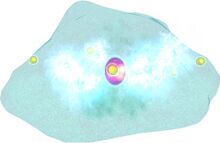Hamidon
This article is about the Devouring Earth monster of Primal Earth. For the Praetorian equivalent, see Hamidon (Praetorian).
| Hamidon | |
|---|---|
 Giant Single-Celled Organism | |
| Details | |
| Real Name | Hamidon Pasalima |
| Gender | Male (before transformation) |
| Origin | Possibly Incarnate |
| Archetype | Giant Monster |
| Affiliation | Master of the Devouring Earth |
| Romantic Associations | Tanya Tyler (before transformation) |
| Signature Powers | Electrolytic Beam, Electrolytic Blast, Protoplasm, Summon Antibodies |
| Zone Locations | The Hive, The Abyss |
Overview
Hamidon is the ultimate monster in the game. A giant amoeba that spawns within The Hive (Hero Side) and The Abyss (Villain Side). Between the Hamidon core and its many surrounding Mitochondria, Hamidon is difficult to defeat. Over time specific strategies have evolved that take 30-50 heroes to defeat Hamidon. Defeating Hamidon results in the award choice of a single random Hamidon Enhancement or 53 merits.
Background
Description
Hamidon is the nucleus of a giant single celled organism, spawned from some twisted primordial soup. It has one instinct, to Devour the Earth and all that infests it.
History
The Hamidon was once a zealous scientist named Hamidon Pasalima. Using hideous dark magic and his own genetic genius, he transformed himself into the god-like monster that would spawn the Devouring Earth and threaten the entire world. In a Q&A done by Razer, developer Black Scorpion implied that Hamidon had somehow been able to tap into the Well of The Furies and turned himself into an Incarnate, which could explain his appearance and massive power.
Hamidon Raids
Main Article: Hamidon Raid
Attempts to defeat Hamidon, generally referred to as Hami Raids, occur regularly on most servers. Since it takes 50+ heroes to defeat Hamidon, these are loosely organized events that bring together many, many heroes, all hoping to acquire a single Hamidon Enhancement.
Over time a basic strategy has evolved for defeating Hamidon. Exact strategy may vary from server to server, but generally it involves several teams of people, and three distinct phases.
Notes
- See Hamidon's Devouring Earth profile for a list of it's powers.